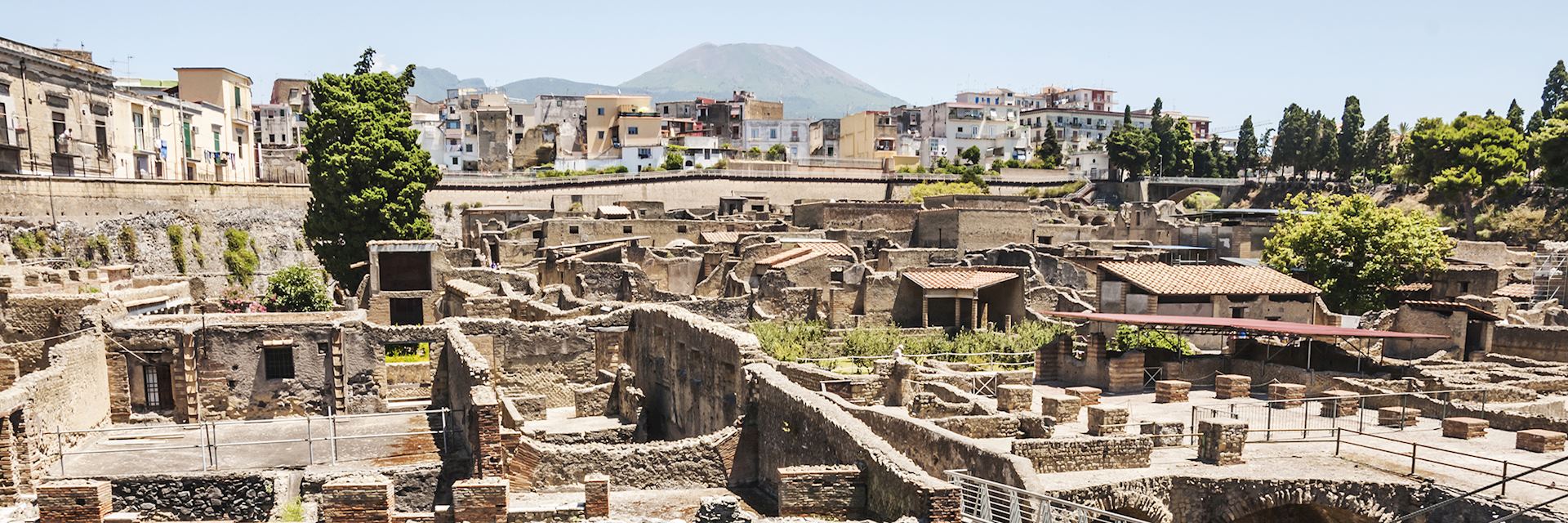Jump to:
Although smaller than nearby Pompeii, Herculaneum is far better preserved. The devastating eruption of Mount Vesuvius in 79 AD covered Pompeii in a thick layer of volcanic ash but left Herculaneum submerged by a 20 m (65 ft) mudslide, which hardened and perfectly preserved the houses, shops, villas and frescoes beneath. The level of detail that survives is extraordinary, from price lists outside shops to wooden doors, beds and decorative objects worn by victims frozen in time. The compact site is easy to get around and unlike in Pompeii, many of the upper storeys of the houses still remain intact.
Italy specialist KimberlyWhile Pompeii is impressive, I actually prefer Herculaneum. The ruins are more intact, and the frescoes are surprisingly vivid. Size isn’t everything, either — some of the site’s smaller houses have some of the best-preserved mosaics.
Things to see and do in Herculaneum
The Villas
Herculaneum appears to have been an exclusive place to live, its grand courtyard houses suggesting a certain wealth and affluence. Richly decorated interiors with intricate frescoes of Roman gods and floors blanketed in beautiful mosaics are matched by elaborate gardens. The House of the Wooden Partition is especially worth a visit to see its perfectly preserved wooden doors. Also worth seeking out is the House of the Deer, a luxurious two-storey villa built around a central courtyard and adorned with intricate still life paintings, while L’Albergo, thought to be an ancient hotel, covers a vast area.
The Thermal Baths
There are two public baths in Herculaneum. The Forum Baths are divided into two sections, as was common practice at the time, one for the men and one for the women. Both sections are well preserved with the original roofs, benches, wooden shelves for clothing, beautiful baths and detailed floor mosaics depicting Triton alongside dolphins. The second baths, the Terme Suburbane, are to the south and are some of the best preserved Roman baths in existence. Inside, the stucco work, mosaics, wooden doors and marble baths remain almost untouched by time, making it difficult to comprehend just how old these artefacts are.
The Shops
One of the most remarkable discoveries in Herculaneum are the shops along the Decumano Massimo, the city's main commercial street. The detail of their preservation offers a unique insight into daily life in the city and across the Roman Empire. You can see ancient wine amphorae, the carved wooden shelving used to store them and, intriguingly, also the price of a jug of wine illustrated outside the shopfront. The bakery's oven and grills remain intact, as do the weaver's looms, the dyer's pots, the taverna counters and the large containers set into marble worktops that would have been used to serve hot food to customers.
who's been there
-
01993 838 92501993 838 960
- Make an enquiry
Suggested itinerary featuring Herculaneum
This sample itinerary will give you an idea of what is possible when you travel in Herculaneum, and showcases routes we know work particularly well. Treat this as inspiration, because your trip will be created uniquely by one of our specialists.
Places near Herculaneum
- Naples 6 miles away
- Pompeii 9 miles away
- Sorrento 13 miles away
- The Amalfi Coast 18 miles away
- Capri 19 miles away
- Ischia 22 miles away
- Matera 119 miles away
- Rome 123 miles away
- Puglia 145 miles away
- Alberobello 152 miles away
- Fasano 158 miles away
- Ostuni 170 miles away
- Orvieto 176 miles away
- Umbria 177 miles away
- Assisi 181 miles away
- Perugia 189 miles away
- Palermo 194 miles away
- Lecce 204 miles away
- Taormina 211 miles away
- Sicily 212 miles away
- Erice and Trapani 214 miles away
- Mount Etna 215 miles away
- Otranto 223 miles away
- Marsala 232 miles away
- Siena 233 miles away
- Villa Romana del Casale 238 miles away
- Agrigento 246 miles away
- San Gimignano 251 miles away
- Costa Smeralda 255 miles away
- Florence 259 miles away
- Syracuse 263 miles away
- Ragusa, Modica & Noto 269 miles away
- Ravenna 273 miles away
- Sardinia 285 miles away
- Pisa 286 miles away
- Bologna 298 miles away
- Southern Sardinia 298 miles away











